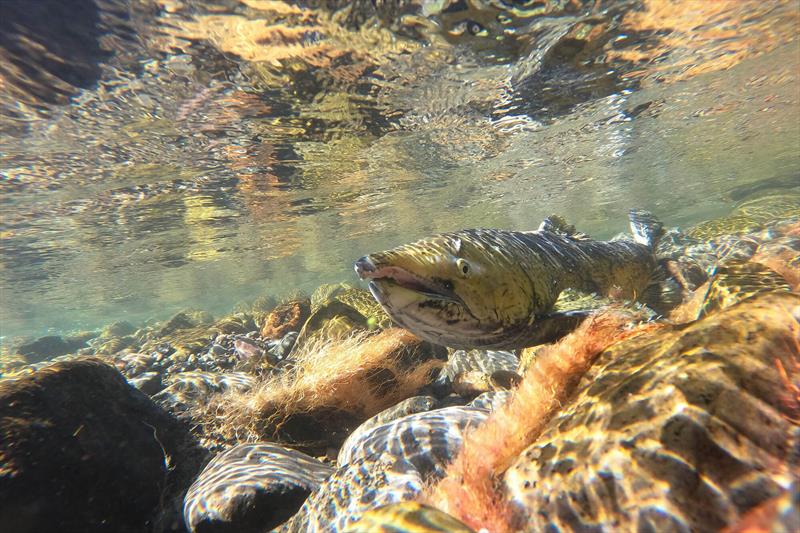
Lack of passage drives continued decline of upper Willamette chinook salmon and steelhead
by NOAA Fisheries 14 Jul 2024 18:44 UTC

A threatened Chinook salmon in the Middle Fork of the Santiam River © Brandon Overstreet / U.S. Geological Survey
Upper Willamette River Steelhead and Chinook salmon should remain listed as threatened under the Endangered Species Act, NOAA Fisheries has concluded in its 5-year review of the status of the species.
NOAA Fisheries must review the status of species listed under the Endangered Species Act at least every 5 years.
Many communities, tribes, and conservation organizations have restored habitat along the Willamette and its tributaries. Chinook salmon and steelhead still lack safe downstream passage past dams that limit access to the high-elevation habitat that once fostered their wild populations. Only further action can halt their continuing decline, which could be compounded by climate change.
"The real issue is that they need safe connections to and from the high-quality habitat we know is above the dams," said Annie Birnie, who led the review. "As long as they remain cut off, we're unlikely to see signs of recovery."
The U.S. Army Corps of Engineers built the Willamette dams to manage flooding that once regularly inundated cities in the Willamette Valley. Some of the dams also generate hydroelectric power. The dams are considerably taller than hydroelectric dams on the Columbia River built specifically to generate power. Below the larger dams, the Corps collects adult fish swimming upstream from the ocean. It hauls them in trucks past higher dams and reservoirs, where they are released to spawn in historic habitat that remains intact.
Of the five historically most productive tributaries of the Willamette River for Chinook salmon, fish can swim freely upstream and downstream only on the Clackamas River. Portland General Electric operates North Fork Dam on the Clackamas, which is unusual in the Willamette because it does have a fish ladder. It's one of the longest in the world. A floating collector in the reservoir funnels juvenile salmon into a pipeline that carries them downstream around the dam to continue their migration to the ocean.
Most tributaries lack passage
The effective fish passage on the Clackamas River makes it an unusual bright spot for salmon among the Willamette tributaries, since fish have no safe outlet to swim past the others. Recent court decisions have directed the Corps to take steps to improve passage on other tributaries, as NOAA Fisheries has long urged. Substantive actions remain years away.
The McKenzie River is one of the few tributaries of the Willamette where Chinook salmon can access spawning habitat throughout most of the basin. A spring-run Chinook population in the McKenzie is stable, but about half the fish come from hatcheries; the population remains far below its recovery goal. The lack of passage around most dams forces other populations to spawn at lower elevations. This makes them more vulnerable to development impacts and climate change, which will put them at higher risk of extinction by about 2040.
Willamette River steelhead and Chinook salmon developed migration timing that allowed them to leap upstream through Willamette Falls when the river was full. They then continued upstream through tributaries into the Cascades to spawn.
"The fish are more vulnerable where they cannot access much of their historical habitat, which they relied on because of the cold, clean water that is important for spawning and rearing," Birnie said.
Viability decline continues
The viability of Willamette River Chinook and steelhead has declined since the last 5-year review and both species remain at moderate risk of extinction. None of the steelhead populations are close to meeting their recovery goals, the 5-year review concluded.
The 2024 5-year review includes priority recommendations for advancing recovery over the next 5 years. The top recommendations include:
- Providing effective upstream and downstream passage
- Operating reservoirs with actions such as "deep drawdowns" that lower reservoir levels in fall and winter to ease downstream migration by juvenile fish
The 2024 5-year review also recommends continuing restoration of lower lying floodplain habitat along the Willamette and its tributaries. This will provide improved refuge for juvenile fish migrating downstream toward the ocean. It also calls for improved monitoring using small passive integrated transponders implanted in many juvenile fish. This will allow us to more fully understand the life cycle and passage needs of Willamette steelhead and Chinook salmon.